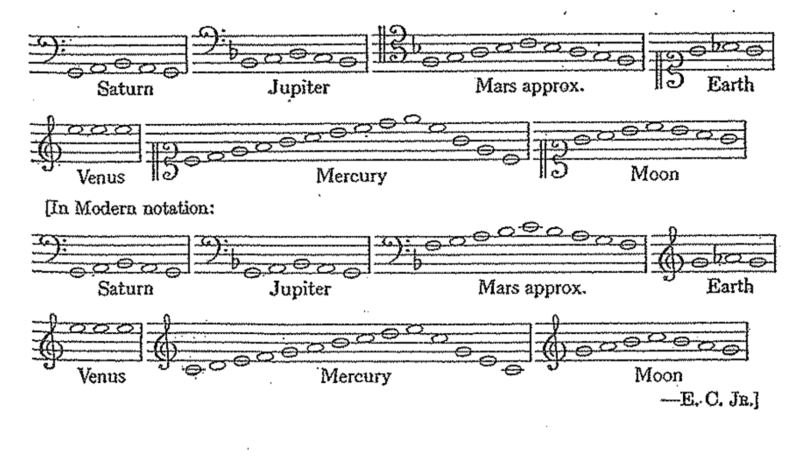A musical composition based on Kepler’s scores intended to interpret the motion of the planets in the solar system.
Kepler’s Cosmos
In 1619, the book The Harmonies of the World, Johannes Kepler discussed the manifestation of harmonies in planetary motion and how music theories apply to such a harmonic consonance. For instance, he scored melodies, representing the movement of the six planets and the Moon around the Sun, as he believed that celestial bodies move in a musically harmonic routine. Furthermore, he attributed vocal parts, including soprano, alto, tenor, and bass, to each planet.
“Kepler’s Cosmos” is a musical composition based on Kepler’s scores, which I created to illustrate Kepler’s musical interpretation of the motion of the six then-known planets in the solar system. The structure is relatively simple. I adopted particular vocal synthesizers to play each planet’s melody in a thirty-second solo period; I placed these periods in the order of the corresponding planet’s proximity to the Sun. Then, in the final thirty seconds, all the melodies for all planets play simultaneously, revealing Kepler’s musical interpretation of the solar system as a whole. Besides the vocal synthesizers playing the main melody for individual planets, I added sound samples as transitions and accompanied each planet’s solo performance with various sound effect synthesizers.
The instrumentation of this project is mainly made up of synthesizers because of their enigmatic features. As mentioned above, I used vocal synthesizers, which make up the melodic portion of the music, to represent each planet’s motion. Meanwhile, I selected diverse sound elements and synthesizers to portray the distinctive impression of each celestial body.

According to Kepler, every one of the planets in the solar system has its vocal part in the celestial harmonies. In chapter 8 of The Harmonies of the World, he assigned each planet their role in the team. He said that “nature gave legal grounds” to Saturn and Jupiter as the bass.1Moreover, he found Mars appropriate for tenor, Earth and Venus for alto, and Mercury for soprano.
Therefore, I assigned particular vocal synthesizers from Logic Pro’s plug-in software Alchemy to each planet based on Kepler’s statement. For instance, “Angelic Choir,” a sweet female vocal synthesizer with a background echo, plays for Mercury. Meanwhile, a melancholy female vocal synthesizer, “Dying Angel,” represents Venus. Furthermore, I utilized a solemn female vocal synthesizer, “Crow Girls,” for the Earth, and an adolescent male vocal synthesizer, “VeVa Rhythm,” for Mars. At last, I had a deep vocal synthesizer, “Strange Alien Chant Generator,” for Jupiter, and another somber one, “Cosmic Boys Choir,” for Saturn. In addition, although Kepler did not assign the Moon with any vocal parts, he wrote the score for the Moon’s movement. Thus, I selected the “Girls Choir” synthesizer because I thought it fit with the melody of the Earth.
The music starts with a synthesizer called “Dark Whisper,” which leads audiences to the mysterious universe. After a game sound, the “Angelic Choir” synthesizer begins to play for Mercury. Meanwhile, I used the other five synthesizers, “Airplanes,” “Aquatic Strumming,” “Diving With Shipwrecks,” “Dreams Illuminated,” and “Dripping,” respectively, so that I could depict the impression of Mercury as a maiden girl. Afterward, the sound of a laser gun enters, and Venus’s section starts. As the “Dying Angel” synthesizer is playing the melody for Venus, other synthesizers “Aftershock Rumble,” “Alien Transmission,” “Bass Noise Cycles,” and “Falling Rock Repetitions” come in to add to the gloomy harmony of Venus.
The music then enters the Earth and Moon section with an awkward cartoon space sound. The Earth’s melody is first played through the “Crow Girls” synthesizer. Then after two bars, the “Girls Choir” starts to play the Moon’s theme. Besides these two synthesizers, the “Deep Cave,” “Citadel Brass,” “Devil In The Deep,” “Low Long Drums,” and “Mad Crazy Glitch” synthesizers also add to the ensemble. The image I portray of the Earth is somehow wicked, to make it contrast with the adorable impression of the Moon. Then the music reaches the Mars section, which creates an animated image of an adolescent boy with a cracking sound. To accompany the “VeVa Rhythm” melody of the Mars, I also added “Alien Dog Affection,” “Binaural Prepared Harpsichord,” “Caffeine Effect,” “Drunken Ghost,” “Conference of Robots,” and “Mechanoid Walker” synthesizers.
Subsequently, a spaceship sound shifts the style of the music from a vibrant atmosphere to a murky one. The “Strange Alien Chant Generator” synthesizer begins to play the deep Jupiter melody. Meanwhile, the “Hungry Ghosts,” “All The Fun Of The Fair,” “Cave Insects,” “Delay Percussion,” “Dark Arrangement FX,” “Mega Oscillations,” and “Nest of Snakes” synthesizers add into the unity. Later, a bumping sound jumps in and leads audiences to the Saturn section, which continues the dark atmosphere of the former area. As the “Cosmic Boys Choir” plays the melody for the Saturn, “Ancient Starship,” “Dark Mallet Echoes,” “Eerie Moment Generator,” “Liquid Ambience,” “Primal Forces,” “Radical,” “Slowing Hopes,” and “SpaceCraft Liftoff” synthesizers add into the harmony.
As the “Dark Whisper” synthesizer exists again, the music approaches its final section—the ensemble of every planet. After the sound of a spacecraft hovering, the seven synthesizers, each representing an individual celestial body, start to play simultaneously. Then, a female voice enters, asking “Do you often stop to ponder about how huge the universe is, and how insignificant we are?” and stops the music.
All of the sound elements, as an audio form, used in this project come from the freesound.org website. Some of these sounds could be adopted without constraint, while others have restrictive licenses. Here are the credits to these sounds: “crackin universe” by jswonger (CC BY 3.0); “Spaceship Fly-by, A” by InspectorJ (CC BY 3.0); “Do you often stop to ponder (voice)” by Jaccia (CC BY 3.0).